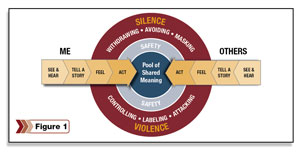Every day there are conversations of different types occurring on your dairy. These interactions happen to everyone, owners, managers and employees – and they are the day-to-day conversations that affect the life of the dairy and the life of everyone involved. It is important for your radar to be at its highest awareness because what makes a conversation crucial is: First, that opinions do vary from person to person. Second, that the stakes are high depending on the situation.
Third, that emotions run high at different times. What makes each of these conversations crucial is that the results could have a huge impact on the dairy and the quality of life of each person involved.
My intent in writing this article is to enable people to handle (even master) crucial conversations in order to step up to and effectively hold tough conversations about virtually any topic. Everyone on a dairy must have the tools to handle life’s most difficult conversations, say what’s on their minds and achieve positive outcomes.
As you begin to imagine yourself holding crucial conversations on the dairy, start with heart. Strong negative emotions will take you to the extremes of silence or violence, which deter the very quality conversation you are trying to hold. Be aware of your emotions.
Scroll down to watch a video of Jorge discussing this topic.
At least be able to recognize and feel the five most basic emotions/feelings we all humans experience: fear, sadness, happiness, anger and love. This is how people who are skilled at dialogue stay focused on their goals – particularly when the going gets tough. Also, work on you first: Remember that the only person you can directly control is yourself.
Let’s use Figure 1 , as a guide for holding crucial conversations and as we go through the process and steps. One fundamental goal of a crucial conversation is to get to a shared meaning so action and results can be achieved. Click here or on the image at right to view it at full size in a new window.
Focus on what you want
Notice that when at the dairy the stakes are high and emotions run high, you or others may be turning to silence or violence during a conversation.
When you find yourself moving toward silence or violence, stop and pay attention to your motives.
Ask yourself: “What does my behavior tell me about what my motives are?” Then, clarify what you really want. Ask yourself: “What do I want for myself? For others? For the relationship?” And finally, ask: “How would I behave if this were what I really wanted?”
Refuse the sucker’s choice
As you consider what you want, notice when you start talking yourself into a sucker’s choice. Watch to see if you’re telling yourself that you must choose between peace and honesty, between winning and losing – and so on. Watch out for getting sucked into one of those.
Break free of these sucker’s choices by searching for the “and.” For example, “I want to win on this idea on lowering somatic cell counts and making Joe lose would not get us anywhere in implementing anything.” Clarify what you don’t want, add it to what you do want and ask your brain to start searching for healthy options to bring you to dialogue.
Learn to look
When caught up in a crucial conversation on the dairy, it’s difficult to see exactly what’s going on and why. When a discussion starts to become stressful, we often end up doing the exact opposite of what works. We turn to the less healthy components of our style under stress.
To break from this insidious cycle, learn to look. Learn to look at content and conditions. Look for when things become crucial. Learn to watch for safety problems (how safe or unsafe people feel). Look to see if others are moving toward silence or violence. Look for outbreaks of your style under stress. Basically, become more aware so you can look and observe not only yourself but others around the dairy during conversations.
Make it safe
Step out: When others on the dairy move to silence or violence, step out of the conversation and make it safe. When safety is restored, go back to the issue at hand and continue the dialogue.
Decide which condition of safety is at risk: The two fundamental conditions of safety are mutual purpose and mutual respect.
Mutual purpose: Do others on the dairy believe you care about their goals?
Mutual respect: Do others on the dairy believe you respect them?
Apologize when appropriate: When you’ve clearly violated respect, apologize.
Contrast to fix misunderstandings: When others on the dairy misunderstand either your purpose or your intent, use contrasting. Start with what you don’t intend or mean. Then explain what you do intend or mean.
CRIB to get to mutual purpose: When you are at cross-purposes or you see people on the dairy stirring away from the mutual purpose you are trying to achieve, use four skills to get back to mutual purpose:
- Commit to seek mutual purpose
- Recognize the purpose behind the strategy
- Invent a mutual purpose
- Brainstorm new strategies
Master your stories
If strong emotions are keeping you stuck in silence or violence during a conversation on the dairy, try this:
Retrace your path
- Notice your behavior. If you find yourself moving away from dialogue, ask yourself what you’re really doing. Am I in some form of silence or violence?
- Get in touch with your feelings. Learn to accurately identify the emotions behind your story.
What emotions are encouraging me to act this way?
- Analyze your stories. Question your conclusions and look for other possible explanations behind your story. What story is creating these emotions?
- Get back to the facts. Abandon your absolute certainty by distinguishing between hard facts and your invented story. What evidence do I have to support this story?
- Watch for clever stories. Victim, villain and helpless stories sit at the top of the list.
Tell the rest of the story
- Ask yourself: Am I pretending not to notice my role in the problem?
- Why would a reasonable, rational, and decent person do this? What do I really want? What would I do right now if I really wanted these results?
State your path
Invariably, there will be tough messages to share with a group or individuals on your dairy from time to time. When you have a tough message to share, or when you are so convinced of your own rightness that you may push too hard, remember to STATE your path:
Share your facts: Start with the least controversial, most persuasive elements from your path to action.
Tell your story: Explain what you’re beginning to conclude.
Ask for others’ paths: Encourage others to share both their facts and their stories.
Talk tentatively: State your story as a story; don’t disguise it as a fact.
Encourage testing: Make it safe for others to express differing or even opposing views.
Explore others’ paths
Whether you have a leader role on the dairy or not, to encourage the free flow of meaning and help others leave silence or violence behind (see Figure 1), explore their paths to action. Start with an attitude of curiosity and patience. This helps restore safety. Then, use four powerful listening skills to retrace the other person’s path to action to its origins.
Ask: Start by simply expressing interest in the other person’s views (ask open-ended questions).
Mirror: Increase safety by respectfully acknowledging the emotions people appear to be feeling.
Paraphrase: As others begin to share part of their story, restate what you’ve heard to show not just that you understand but also that it’s safe for them to share what they’re thinking and feeling.
Prime: If others continue to hold back, prime. Take your best guess at what they may be thinking and feeling, express it and test for agreement or disagreement.
As you begin to share your views, remember a quick ABC:
Agree: Agree when you do.
Build: If others leave something out, agree where you do, then build.
Compare: When you do differ significantly, don’t suggest others are wrong. Compare your two views (keeping it safe to continue dialogue).
Move to action
Any dairy at any point in time runs and produces results because people moved from decisions to action. Turn your successful crucial conversations into great decisions and united action by avoiding two traps: violated expectations and inaction.
Decide how to decide
As weird as this may sound, it is huge in helping with the decision part of the process on your dairy. Here are four options:
- Command: Decisions are made without involving others.
- Consult: Input is gathered from the group and then a subset decides.
- Vote: An agreed-upon percentage swings the decision.
- Consensus: Everyone comes to an agreement and then supports the final decision.
Finish clearly
As you close with an action plan for the dairy or a specific area of the dairy, determine who does what by when. Make the deliverables crystal clear. Set a follow-up time. Record the commitments and then follow up. Finally, hold people accountable to their promises and hold yourself accountable for yours.
As you continue progress on your dairy, crucial conversations will play a role in changing the overall conversations in your business. People will feel more clear about communication and will feel engaged and energized about being in action and producing results that make a difference. PD

Jorge Estrada
President & CEO
Leadership Coaching International Inc
VIDEO








